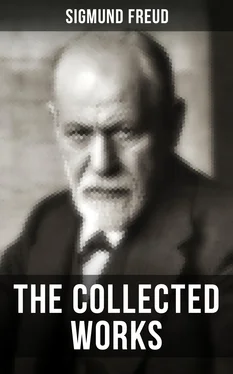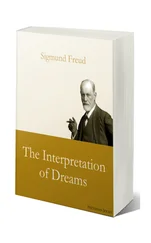TWENTY-FOURTH LECTURE
GENERAL THEORY OF THE NEUROSES
ORDINARY NERVOUSNESS
Table of Contents
In our last discussion we accomplish a difficult task. Now I shall temporarily leave our subject and address myself to you.
For I know quite well that you are dissatisfied. You thought that an introduction to psychoanalysis would be quite a different matter. You expected to hear vivid illustrations instead of theories. You will tell me that when I gave you the illustration of “on the ground floor in the first story,” you had grasped something of the causation of neurosis, only of course this should have been a real observation and not an imaginary story. Or, when in the beginning I described two symptoms (not imaginary also, let us hope) whose analysis revealed a close connection with the life of the patient, you first came to grasp the meaning of the symptoms and you hoped that I would proceed in the same way. Instead I have given you theories — lengthy, difficult to see in perspective and incomplete, to which something new was constantly being added. I worked with conceptions that I had not previously presented to you, abandoned descriptive for dynamic conceptions, and these in turn for economic ones. I made it hard for you to understand how many of the artificial terms I made use of still carry the same meaning and are used interchangeably only for the sake of euphony. Finally, I allowed broad conceptions to pass in review before you: the principles of pleasure and of fact and their phylogenetically inherited possession; and then, instead of introducing you to definite facts, I allowed them to become increasingly vague till they seemed to fade into dim distances.
Why did I not begin my introduction to the theory of neurosis with the facts that you yourselves know about nervousness, with something that has always aroused your interest, with the peculiar temperament of nervous people, their incomprehensible reactions to external influences, to human intercourse, their irritability, their uselessness? Why did I not lead you step by step from the understanding of simple, everyday forms to the problems of mysterious and extreme manifestations of nervousness?
I cannot even say that you are wrong. I am not so infatuated with my art of representation as to see some special attraction in every blemish. I myself believe that I could have proceeded differently, to your better advantage, and this indeed had been my intention. But one cannot always carry out one’s sensible intentions. The nature of the subject matter issues its own commands, and easily modifies our plans. Even so usual a performance as the organization of well-known material is not entirely subject to the particular purposes of the author. It forms itself as it will and later one wonders why it turned out so and not otherwise.
Probably one of the reasons is that the title, A General Introduction to Psychoanalysis , no longer applies to this part, which deals with the neuroses. The introduction to psychoanalysis is found in the study of errors and the dream; the theory of neurosis is psychoanalysis itself. I do not think that in so short a time I could have given you a knowledge of the theory of neurosis other than in concentrated form. It was necessary to present to you connectedly the meaning and interpretation of the symptoms, their external and internal conditions and their bearing on the mechanism of symptom formation. This I have attempted to do; it is practically the nucleus of the material that modern psychoanalysis is able to offer. We had to say quite a good deal concerning the libido and its development, and something as well concerning the development of the ego. The introduction had already prepared you for the presuppositions of our technique, for the large aspects of the unconscious and of suppression (resistance). In a subsequent lecture you will learn from what points psychoanalysis proceeds organically. For the present I have not sought to hide from you the fact that all our results are based on the study of a single group of nervous affections, the so-called transference neuroses. Though you have gained no positive knowledge and have not retained every detail, still I hope that you have a fair picture of the methods, the problems and the results of psychoanalysis.
I have assumed that it was your wish for me to begin my presentation of neuroses with a description of nervous behavior, the nature of neurotic suffering, and the way in which the nervous meet the conditions of their illness and adapt themselves to these. Such subject matter is certainly interesting and well worth knowing. It is moreover not very hard to handle, yet it is not wise to begin with its consideration. There is danger of not discovering the unconscious, of overlooking the great significance of the libido, of judging all conditions as they appear to the ego of the nervous person. It is obvious that this ego is neither a reliable nor an impartial authority. For this very ego is the force that denies and suppresses the unconscious; when the unconscious is concerned, how then could we expect justice to be done? The rejected claims of sexuality stand first in the line of these suppressions; it is natural that from the standpoint of the ego we can never learn their extent and significance. As soon as we attain to the point of view of suppression, we are sufficiently warned not to make one of the contending factions, above all not to make the victor judge of the struggle. We are prepared to find that the testimony of the ego may lead us astray. If one is to believe the evidence of the ego, it would appear to have been active all along, all its symptoms would have been actively willed and formed. Yet we know that it has passively allowed a great deal to occur, a fact which it subsequently seeks to conceal and to palliate. To be sure, it does not always attempt this; in the case of the symptoms of compulsion neurosis it must admit that it is being opposed by something alien, which it can resist only with difficulty.
Whoever does not heed these warnings not to mistake the prevarications of the ego for truth, has clear sailing; he avoids all the resistances which oppose the psychoanalytic emphasis upon the unconscious, on sexuality, and on the passiveness of the ego. He will assert with Alfred Adler that the “nervous character” is the cause instead of the result of the neurosis, but he will not be able to explain a single detail of symptom formation or to interpret a single dream.
You will ask: Is it not possible to do justice to the part the ego plays in nervousness and in symptom formation without crudely neglecting the factors revealed by psychoanalysis? I answer you: Surely it must be possible and at some time or other it will take place; but the methods by which we organize the work of psychoanalysis do not favor our beginning with just this task. We can foresee the time when this task will claim the attention of psychoanalysis. There are forms of neuroses, the so-called narcistic neuroses, in which the ego is far more deeply involved than in anything we have studied heretofore. The analytic investigation of these conditions will enable us to judge reliably and impartially the part that the ego plays in neurotic illness.
One of the relations which the ego bears to its neurosis is so obvious that it must be considered at the very outset. In no case does it seem to be absent, and it is most clearly recognizable in the traumatic neuroses, conditions which we do not as yet clearly understand. You must know that in the causation and mechanisms of all possible forms of neurosis, the same factors are active again and again; it is only the emphasis that is shifted from one to the other of these factors in symptom formation. The members of a company of actors each have certain parts to play — hero, villain, confidant, etc. — yet each will select a different drama for his benefit. Thus the phantasies which undergo conversion into symptoms are especially easy to detect in hysteria; compulsion neuroses are essentially dominated by the reactionary formations, or counter-seizures of the ego; what we designate as secondary elaboration in dreams dominates paranoia in the form of delusions, etc.
Читать дальше












